How Much Do Podcasters Make?

Whether as a side hustle or a full-time venture, creating podcasts can not only be a creative outlet but a way to earn money.
The world’s top podcasters can make millions of dollars from their shows, though they only represent a very small percentage of the estimated 2.87 million podcast series that exist. The vast majority of podcasters are making only a little bit of money, or none at all.
However, if you consistently make great episodes and grow your listeners, it’s very possible to make a stable side income with a successful podcast, or even approach it as a full-time job with income that matches.
It really all comes down to numbers — how many people are listening to your episodes? The more listeners you have, the higher your potential income.
The biggest potential source of revenue for podcasts is sponsored ads inserted into an episode. The rate you can command for these is typically calculated as CMP, or cost per mille, which usually means a cost per one thousand listeners.
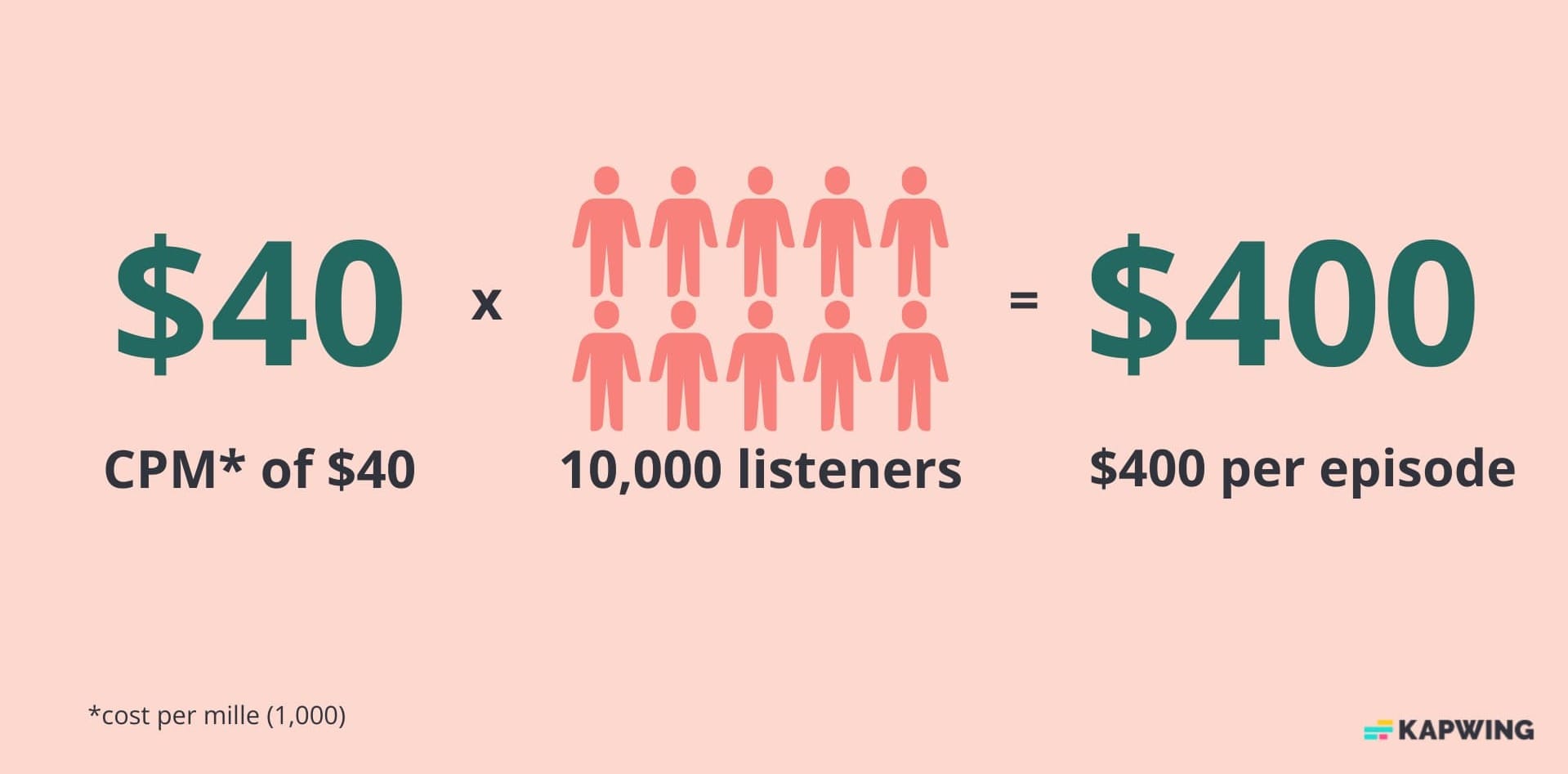
The math is pretty simple. If your advertiser offers $40 CPM, and you have 10,000 listeners, that means you’ll be paid $400 for that episode.
That CPM rate can vary a lot.
A huge show with millions of downloads and celebrity guests can command a higher rate, while a new show just getting started will be offered less. The quality of your listeners also matters. If you can show advertisers that you have a highly-engaged, niche audience — like a B2B podcast, for example — you may be able to get a higher CPM.
According to Influencer Marketing Hub, the average CPM for podcasts ads that are 30 seconds long is about $18. For 60-second ads, the average CPM is $25.
Looking at that, if you have 10,000 listeners and release weekly episodes with a 30-second ad, that translates to $720 per month.
Although advertising is core to most podcasters’ revenue strategy, it’s not the only way people make money podcasting. Here, we’ll go over all the most popular podcast monetization methods you can use to make money, as well as look at what the top podcasters make. We’ll end with a reality check of what the you can expect to earn if you make a podcast.
How to make money from a podcast
As we said, ads are important but far from the only way to make money podcasting. Let’s take a closer look at each option.
Sponsored ads
Let’s start with the most lucrative of all the podcast monetization methods — ad placements. This is the method that most successful podcasts rely on.
There are certainly a lot of brands interested in working with podcasts — podcasting ads generated more than $1.8 billion in the US in 2022. Podcast ads are very attractive to brands because they resonate with listeners. Edison Research found that 51% of podcast “Super Listeners” — people in the US who listen to at least five hours of podcasts weekly — said they pay more attention to ads on podcasts than on other media. As well, 53% said their opinion of a company is more positive when it is on a podcast they regularly listen to.
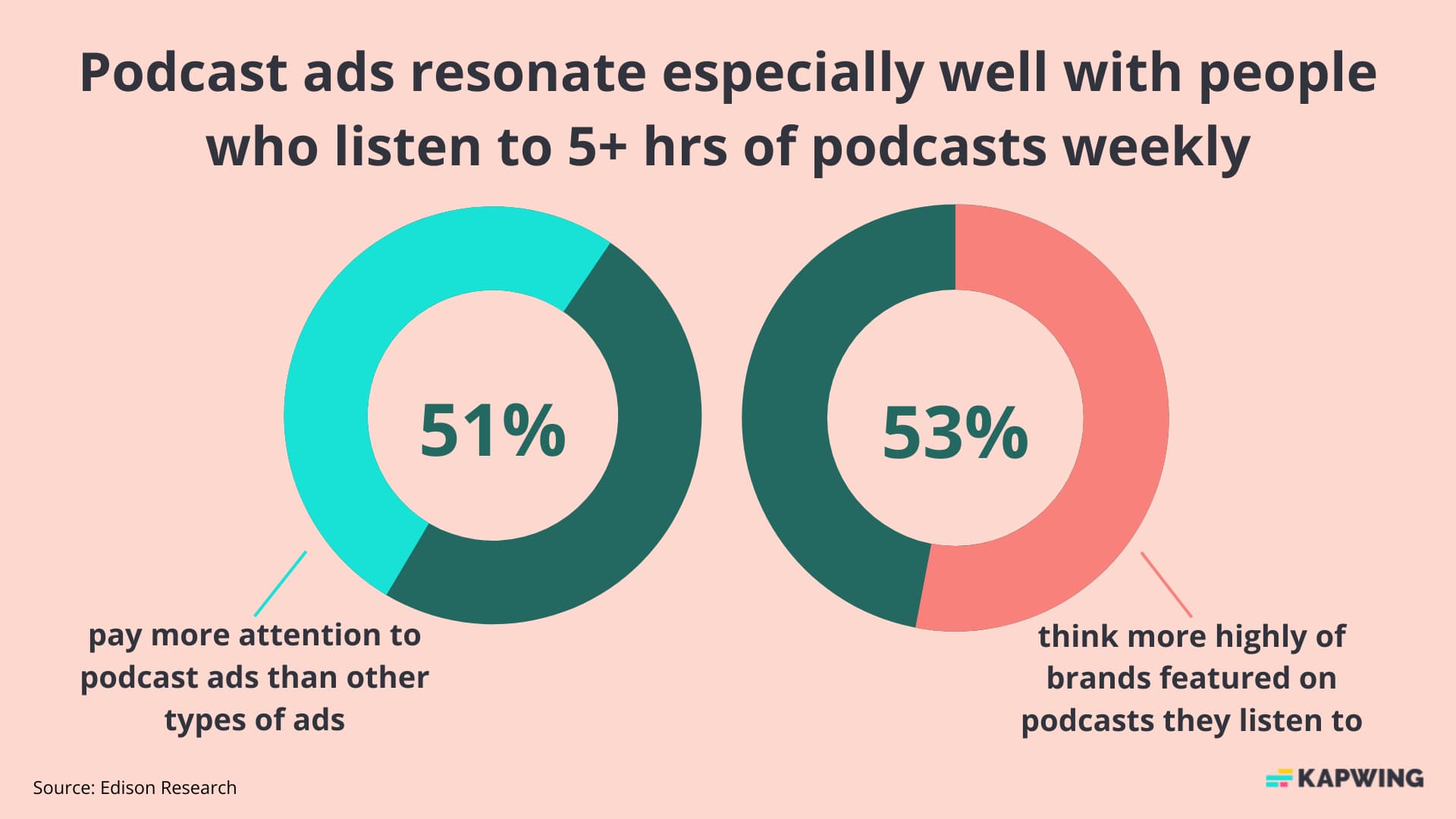
There are different ways to place ads within a podcast, but they all come down to a brand paying to have their products or services mentioned in a podcast episode.
The two main types of podcast ads are:
- Pre-recorded ads, typically supplied by the brand. These are sometimes bought programmatically by brands across several podcasts.
- Host-read ads are brand mentions spoken by the actual podcast host or hosts, with guidance or approval from the brand. These are typically cited as the most effective ad type for brands and research from Acast found that 72% of listeners said they visited a brand's website after hearing a host-read ad.
Podcast ads can also play at different sections of a podcast episode:
- Pre-roll ads play the very beginning of an episode, making them hard for a listener to miss.
- Mid-roll ads play somewhere within the main section of a podcast.
- Post-roll ads play at the end of an episode. These get the least attention because podcast listeners may have already turned the episode off.
These different ad types play a factor in the CPM of a campaign. A pre-roll ad that’s read by the podcast host can command a higher CPM than a pre-recorded post-roll ad.
“Sponsored ads are the best way to make money with a podcast,” says Jack Dodge, host of Kapwing’s YouTube channel and a former podcaster and host of Dating Straight.
“Sponsored ads are also great because you can put several of them in a single episode. Our podcast episodes usually had between three and six ads, meaning we could generate a few thousand dollars per episode.”
Sponsored ads are often bought in packages — for example, one ad spot in a package of eight podcast episodes, or even a full season. Securing a package deal means more consistent and reliable income. The more ads you run and the more downloads you have, the higher your earning potential from podcast ads.
Affiliate sales
Another way to make money as a podcaster is affiliate sales. This is when you promote a product or service in your podcast and make a small commission each time a listener makes a purchase.
You’ve probably heard this happen on a podcast yourself, like when a host says to use their unique code or affiliate link for 10% off from a brand. That code or affiliate link tracks sales and gives the podcast a percentage or flat rate for each sale.
The trick to making income through affiliate sales is to find brands with affiliate programs that align with your podcast audience. A podcast about pets or animals would pair well with a brand like Barkbox, a monthly dog product box that has an affiliate program. Or, if your podcast is about technology or entertainment, ExpressVPN’s affiliate program might be a good fit.
Audible is another popular option, regardless of your podcast niche, because podcast listeners are already more likely to be interested in audiobooks.
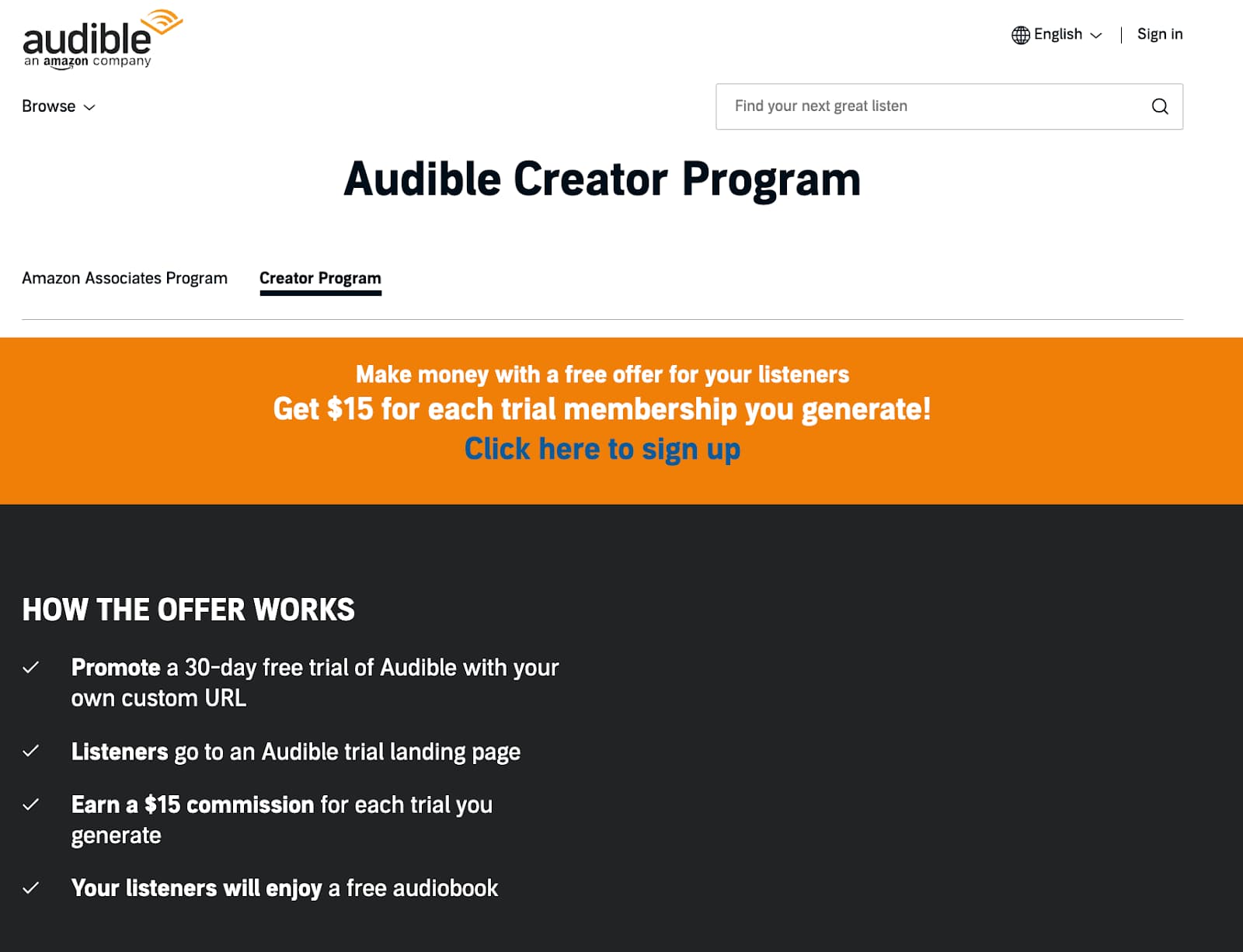
It’s important to have a sense of who your podcast audience is, such as their age, gender, and location. This will help you when negotiating with sponsored ad placements, but also with finding affiliate marketing partnerships that will convert.
The brands with affiliate programs typically pay a flat rate per purchase or sign-up, and some have a cap of how much you can earn per month.
Research brands you’re interested in working with to find out if they have an affiliate program. Some have an automated program, like Audible, and with others you’ll have to reach out to get your unique code or URL.
You can also choose to work with multiple affiliate programs — just don’t forget to share your code or URL in your show.
Patreon and premium subscriptions
Podcasts are almost always free to download and listen to, but there are options to create a premium experience for a premium price.
The first and most popular option is to launch a Patreon for your podcast. Patreon is a website that allows anyone to convert the fans into members of an exclusive club. Members pay a monthly fee to support their favorite creators and gain access to rewards like exclusive content.
Creators on the platform can create their own fee structure, although premium plans on Patreon will take either 8% or 12% of your total earnings.
The Basement Yard is a great example of a successful podcast with a Patreon campaign. They have over 27k paid members across three different membership tiers at the time of writing this. Even if all of those members were only paying the lowest tier of $5 per month, that’s a massive $136,120 per month, minus fees from Patreon.
While some fans will be happy to pay a small amount just to support you, to really gain members on Patreon you have to offer something of value.
Below, you can see what The Basement Yard offers its Patreon members. The most basic plan includes getting podcast episodes a week early, while the higher plans include an exclusive, extra episode every week. They also offer discount codes on their merch to members.
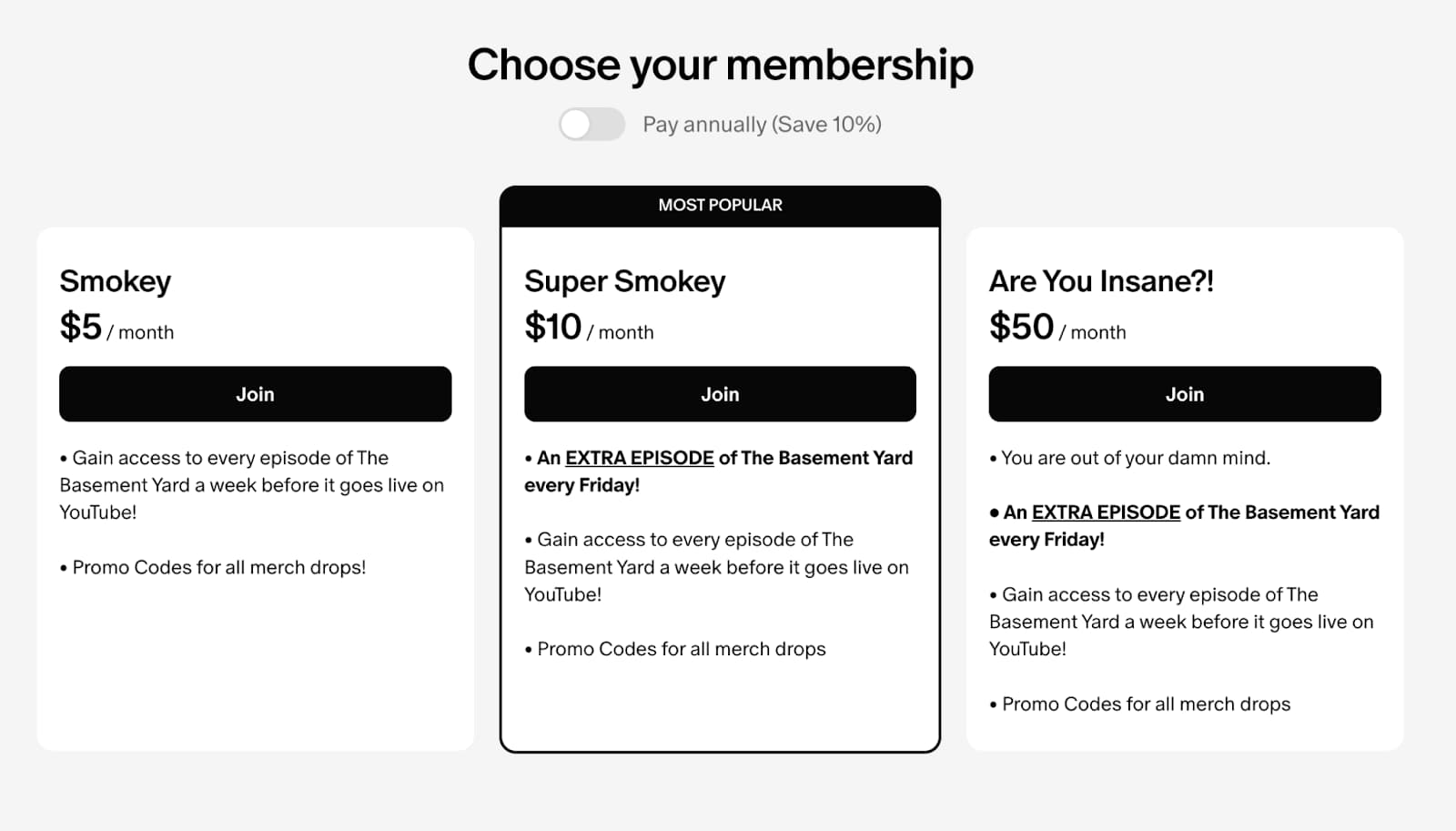
For true fans, those perks make membership totally worth it. Invite podcast listeners to join the Patreon for your own podcast by mentioning it and its perks in your episodes.
Another way to create a fee structure is with premium subscriptions, such as with Apple Podcasts Subscriptions. This allows you to charge a monthly or yearly subscription fee and, in return, provide a premium tier of episodes, like ones without advertisements, or bonus episodes just for subscribers. Spotify also offers a similar paid subscription option.
Sell your own products
Creating and selling your own products is a common podcast revenue stream.
This could be as simple as creating fan merchandise — for example, t-shirts, mugs, and mouse pads with your logo, funny quotes from the show, or images of your hosts.
There are several ways to go about creating fan merchandise. First, there’s purpose-built services for merch such as TeePublic, Bonfire, or Teespring. On those sites, you upload your designs, choose products, and direct fans to the website to make a purchase. The website will take care of printing and shipping the goods, giving you a small percentage of the sale.
The You’re Wrong About podcast, for example, sells merchandise on TeePublic, including apparel and home goods.
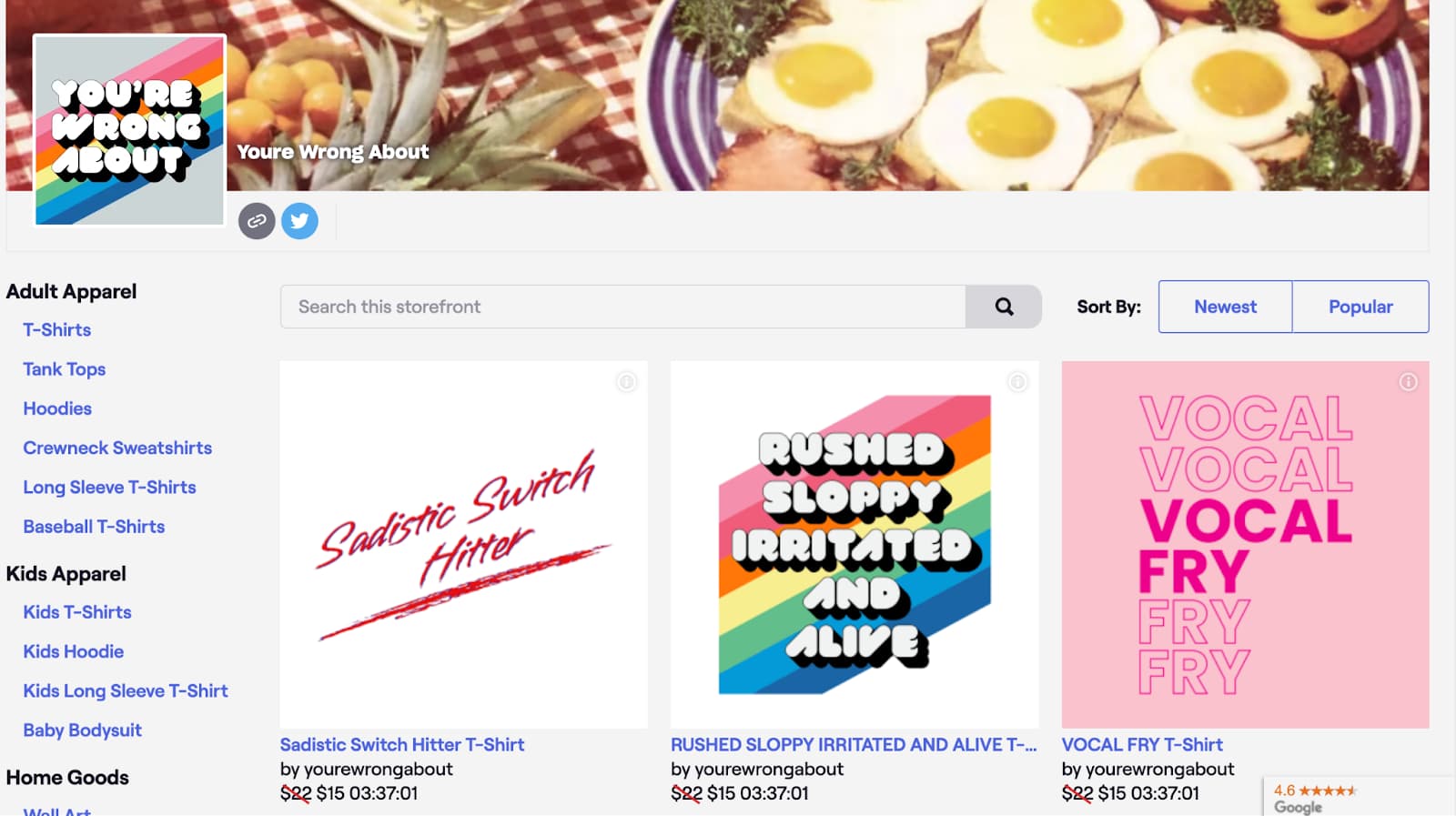
A slightly more complex option is to create your own merchandise website with a provider like Shopify or BigCommerce and partner with a print-on-demand service, like Printify, Printful, or Gelato. Fans make the purchase through your website, but the print-on-demand provider prints the product and ships it. You can keep a higher percentage of the sale with this option, but only by a bit.
The most involved option is to create a merch website and produce and ship the goods yourself, either by printing at home or by buying your goods wholesale. This requires a much bigger investment up front, but you’ll keep more of the profits.
Basic fan merch is just one of many things you can sell. You could create a whole new product from scratch and launch a whole e-commerce venture, or you could sell digital goods like e-books, an online course, or downloadables. If you make it big in podcasting, you could even start selling podcast related services.
Like with affiliate marketing, you want to sell products that will resonate with your niche audience.
Promote your business
Perhaps you already have a business and the purpose of your podcast is to attract new clients or customers.
Podcasts are a great way to connect with customers, share your brand’s story, and attract new customers all at the same time.
If you’re a B2C or DTC business, your podcast is likely a branded podcast, a company podcast, or an enterprise podcast. Some very successful podcasts are in fact produced by brands, such as Trader Joe’s: Insider Trader Joes. It started in 2018 as a look behind the scenes at the grocery store, but is still going strong with 67 episodes plus bonus mini episodes.

For a B2B podcast, your goal is to attract and retain business clients, who tend to be savvy consumers that take much longer to complete the customer journey from awareness to conversion. Instead of launching right in with the hard sell, we recommend using your B2B podcast to share your expertise and take a deep dive into your industry.
A great example of this is HubSpot’s podcast network, which has 39 shows aimed at professionals.
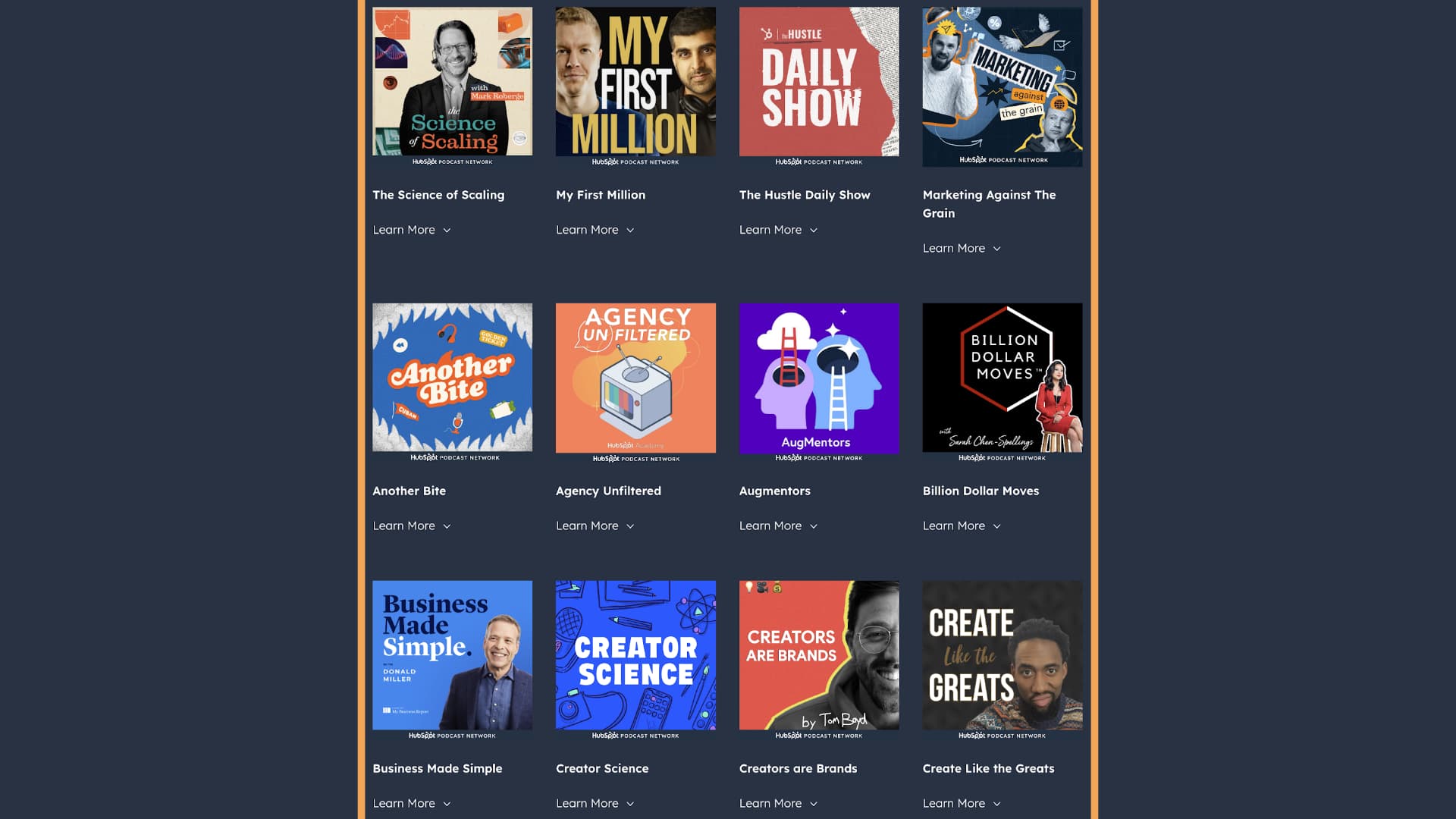
Promoting your business with a podcast can add real value to your brand. According to the Future of Marketing newsletter, 42% of decision makers use podcasts to access business-related content. As well, organizations with branded podcasts reported 89% higher awareness and 57% higher brand consideration.
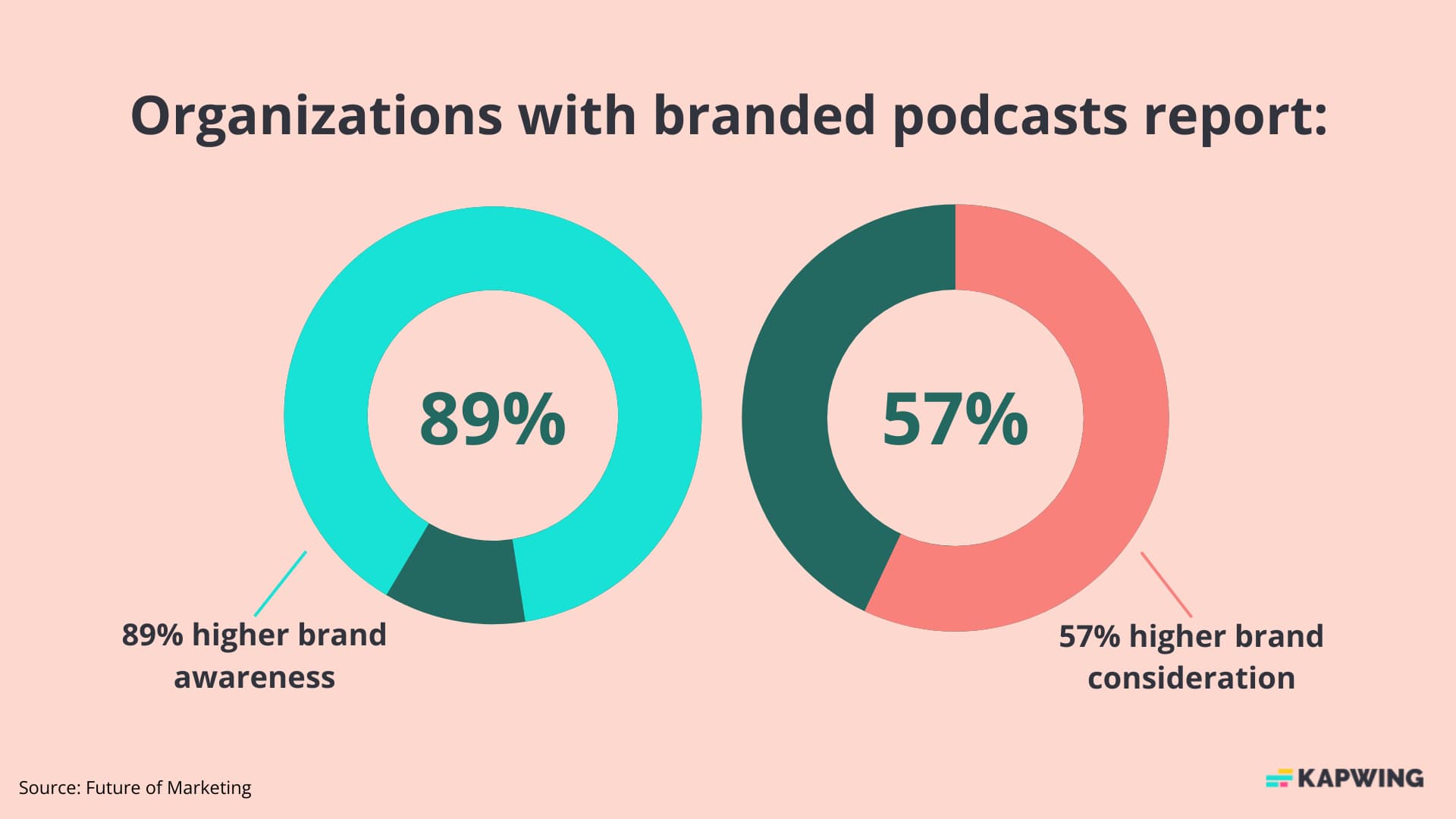
Share podcast clips on social media
Finally, you can make extra income with your podcast by sharing and monetizing clips on social media.
While you can add waveforms and graphics to create clips from an audio-only podcast, these types of posts don't perform as well as actual video footage of people talking. That's why we highly recommend creation a video podcast. Most very successful podcasts record a video version and more and more, it's becoming table stakes for smaller shows as well.
For short-form clips, the best platform to upload to is TikTok. Although the TikTok Creator Program is sunsetting, the new TikTok Creativity Program rewards creators that post videos of at least one minute long to the platform. To join the program, you need to be in the US, be at least 18, and have at least 10,000 followers and at least 100,000 video views in the last 30 days.
The other place you can monetize videos of your podcast is on YouTube. Some creators upload clips, while others upload whole episodes. Either way, you can monetize these videos with AdSense and the YouTube Partner Program. This can actually boost your CPM for sponsored ads because you can add your YouTube views to your listener count.
Some of the most successful podcasts have larger audiences on YouTube than more traditional podcasting platforms. The Bad Friends podcast, for example, has 1.16 million YouTube subscribers.
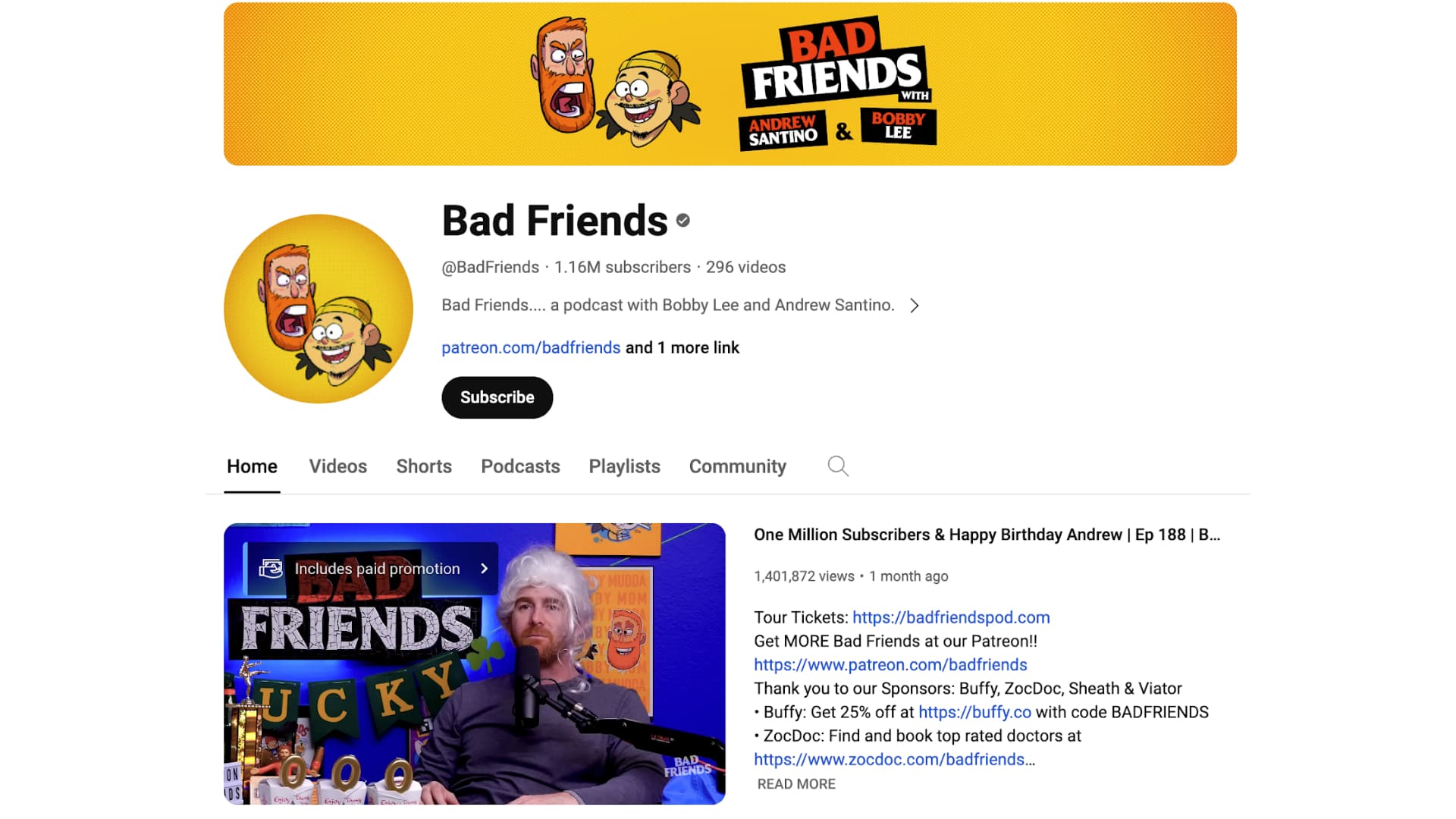
How much do the highest paid podcasters make?
You’re probably wondering — how much do podcasters make when they’re actually successful? The answer is a lot. The highest-earning podcasts make millions per year and it typically comes down to how many listeners they have and what kind of brands they can attract.
Here’s a snapshot of the income top podcasters make:
- The Bill Simmons podcast earned an estimated $7 million as of 2020
- Joe Rogan’s deal with Spotify was reportedly worth over $200 million
- My Favorite Murder reportedly earns $15 million annually and the Exactly Right Media podcasting network (owned and produced by the MFM hosts) was acquired for more than $100 million by Amazon.
- Dax Shepard, host of Armchair Expert, was reported to have made $13 million in 2019
These are estimates of course, as podcasters don’t typically share their revenue details. But the general theme here is that a celebrity-sized podcast can earn quite a lot.
Temper your expectations for your own podcast, though. Podcastle estimates that average podcasts with 10,000 downloads per episode can earn from $500 to $900 per episode.
With a bit of work, you can definitely beat that. Jack Dodge, who we heard from earlier, said you can reasonably expect to earn $100 per 1,000 downloads or listens if you consistently have several ads per episode. His own podcast earned about $3,500 per episode.
Keep in mind that you may not get to keep all that money. Starting a podcast requires an investment in podcasting equipment and if you hire outside editors or producers, they’ll get a cut, too.
Diversify your podcast revenue
The big question was “how much do podcasters make?” and the answer is more complex than a simple estimate.
The truth is that a podcast can earn you nothing, to a few dollars, to a steady income, to millions in revenue. Podcasts make money based on listeners, so the more you can get, the higher you can aim for your podcast income.
The best way to make money podcasting is to diversify your revenue streams. Sponsorships will always be the highest earner and should be the pillar of your marketing and advertising strategies, but you can add on to that with affiliate sales, selling products or an online course, or promoting your business. Adding new podcast monetization methods increases the total you can earn.
And, of course, the best thing you can do is consistently publish new episodes and always create interesting podcast content.
Identify the best revenue streams for your unique show and see how much your podcast can earn.
Read these next:









